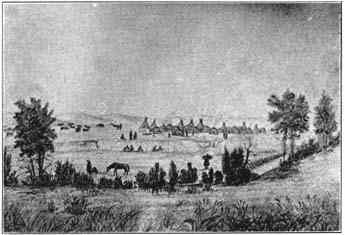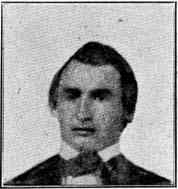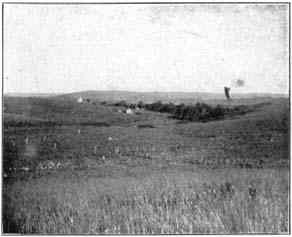tion to provide farms for such of the Poncas as returned to Nebraska. There were 233 of them in the old neighborhood at the last census. The men are citizens of the state and vote at all elections the same as white men. Standing Bear, now past seventy, but strong and vigorous, owns 400 acres of beautiful valley land on the Niobrara and when the photograph which illustrates this text was taken,--July 25, 1904,--sent his warm remembrances to the only living one of the two Omaha lawyers who made the successful fight for his own liberty and the fights of his people a quarter of a century ago. There are 557 of the tribe in Oklahoma on a new reservation given them by the government in 1881 and on which they have been content to remain. 
Omaha Indian Village on Papillion Creek, 1854. Ohio and the Wabash, centuries ago to the junction of the Missouri and Mississippi. From this point they worked their way northwest, the Osages making their home on the river which bears their name in Missouri, the Otoes following up the Missouri to the Nemaha and Platte, while the other three journeyed by slow stages across the state of Iowa to the Great Pipestone quarry in southwestern Minnesota. Wars with the Yankton Sioux drove them across the Missouri river and they became residents of Nebraska about two hundred years ago. Since that time their village site has been moved from Blackbird Creek to Bell Creek near Fremont, from there to Salt Creek above Lincoln, from Salt Creek back to Blackbird, from there to the Elkhorn near West Point, from West Point to Shell Creek, from there to Omaha creek, from Omaha creek to the Elkhorn near Wisner, from there about the year 1832 to Omaha Creek, in 1845 to the neighborhood of Bellevue and in 1855 to the present location where they have since lived. |
of men and women of remarkable ability whose names are treasured in the tribal lore and will be themes for future poets and novelists. Two or three only may be mentioned here. Blackbird, the most cruel and despotic of all the Omaha chiefs, died of smallpox in 1800. Stories of the fear he inspired are common. He was recognized by both French and Spanish governors at St. Louis as a great chief and original commissions issued to him as such are in the State Historical Society collections. After Blackbird, Big Elk was head chief and the accounts of the exploring expeditions in the early part of the last century have frequent tributes to his good qualities. He was succeeded by Iron Eye or Joseph LaFlesche who was the pioneer in teaching the tribe to adopt civilized customs and methods of farming. His daughter, Bright Eyes, became an author, a public speaker in behalf of her race in Europe as well as America and the wife of T. H. Tibbles, populist candidate for vice-president in 
Logan Fontanelle 1904. A son, Frank, has written several books on Indian life and is in the Indian Bureau at Washington. The popular hero among the Omahas is Logan Fontanelle, son of a French trader and Omaha woman. He was the first Omaha chief who could speak English as well as Indian. In the summer of 1856 he was killed in a battle with the Sioux on Beaver Creek in Boone county. He was buried in his own door yard on a wooded point about a mile north of Bellevue. The whole Omaha nation and the white settlers as well, attended the funeral and mourned his loss. 
Omaha Agency. Looking Southeast. The Omaha tribe has always been at peace with the whites, sometimes at war with the Pawnees, Poncas and Otoes and practically always at war with the Sioux. In the early part of the century they lost half the tribe by smallpox, but suffered far less than their neighbors by the white man's liquor, which destroyed the Otoes and Pawnees. This was largely due to the action of the leading men who called a council over fifty years ago, which passed stringent laws against the use of liquor and enforced them for many years with severe punishments by the "soldier lodge," the tribal militia and police. The tribe now numbers about 1,100 people, living in comfortable homes on their beautiful reservation in Thurston county; The men are voters in the state they have good right to call their own, and the future prospect is that so long as there are Nebraskans some of them will carry Omaha blood in their veins. |
 |
 |
 |
 |
|
@ 2002 for the NEGenWeb Project by Pam Rietsch, Ted & Carole Miller |
|||